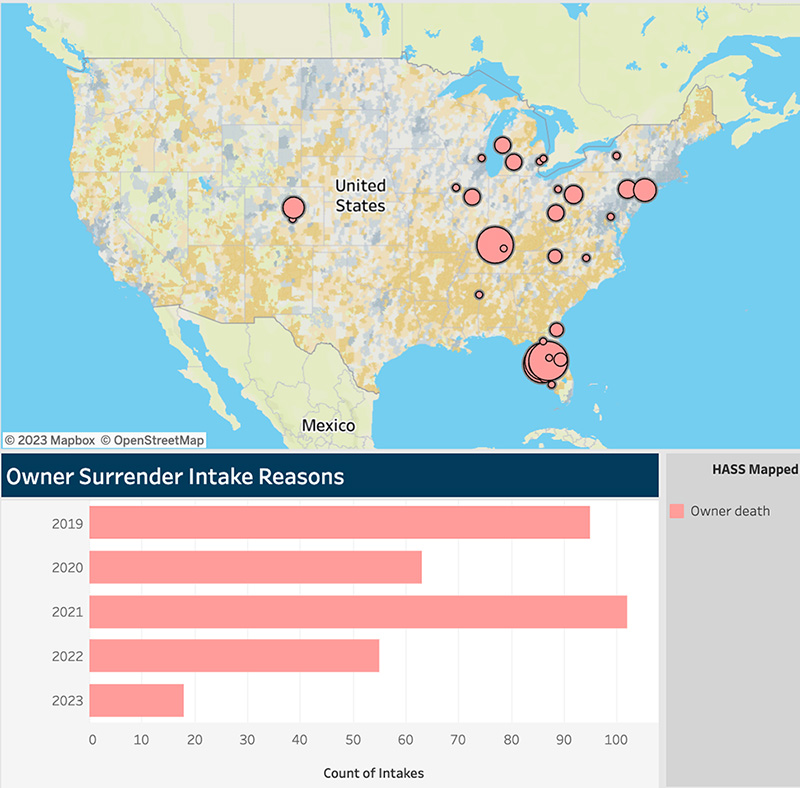One of the sadder things we see in shelter intake lobbies is when someone arrives to surrender the beloved pet of a deceased family member or of a loved one unable to care for a companion. HASS believes there are other solutions to consider before a shelter surrender, especially in sensitive moments such as these, that can benefit both the family in need and a shelter’s ability to manage intake in a positive way. But how can shelters still support this need?
It begins with intake data.
At HASS, it’s increasingly clear there is much to be gained from close attention to intake data. What shelters learn and record at intake can allow not only a better understanding of the problems that funnel pets into your shelter, but to create proactive responses that reduce overcrowding before it happens. You won’t prevent all intake, but you might just make your shelter population more manageable and, most importantly, support your community better.
To do this, you first need to break down the situation by paying close attention to why pets are entering your shelter. This means committing to an accurate recording of why each animal arrives at your door. (We’ll be discussing how to do this in the coming months as we dive into an intake reasons project in 2024.) You can then systematically devise solutions addressing each reason.
Even small reductions in intake can help. For example, in 2022, pets whose owners had passed away or became unable to care for a pet because of illness made up a relatively small percentage of intake at the 22 HASS pilot organizations. Approximately 4% of all animals surrendered or returned were recorded as due to death or illness of the owner. This resulted in over two thousand (2,326) pets entering shelters among the 22 HASS pilot organizations alone—in that one year. That’s a relatively small number, but if a way to avoid those pets coming into the shelter year over year is also relatively easy, then it makes sense to try.
Aside from the numbers, the knowledge you gain from intake data also can help you be a better steward of people and pets in your community. HASS operates on the central principle that helping people is the best way to help pets, and we strive to deploy our data to support that principle. This requires understanding the situations that people find themselves encountering in the care of pets.
When collaborating on intake data with a HASS pilot shelter located on the west coast of Florida, Pasco County Animal Services, the Data & Research team mapped the addresses of people who had come to surrender a pet because a family member had passed away. The map made us sit up and take notice that many of those people had traveled from points around the country. In the midst of arranging a funeral, a pet left behind would probably become a complication that the family could not manage in such a moment. Even if they expected to keep the pet, the logistics of getting a pet back to their home would be difficult.
What would be needed is a proactive solution, yet people are not always aware of this need. This is where a shelter can both better serve its community and help themselves with managing shelter populations.

For example, if intake data indicates that many people who surrender a pet due to the original owner’s health or death are traveling to your community to do so, you can stress the importance to your immediate community of creating both short- and long-term plans for their pets’ care in the event of a crisis, and discussing it with their network of family and friends.
Here are some low-lift practical steps shelters can communicate to their community in order to ensure beloved companions are taken care of, no matter what the future may hold.
- Encourage the people in your community to talk to friends and family about their pets prior to unforeseen circumstances and make a plan. Keeping pets within their own social network ensures their pets will have a seamless line of care with people they are more likely to know and be comfortable with. You can promote these conversations in a number of ways: through social media, a webinar or video posted on your website, communications outreach (flyers, pamphlets), or getting a story placed in local media.
- Supply human welfare agencies that work with the elderly or leaders of retirement communities, or mental health agencies, etc., with information and flyers about how to line up care for pets, or send a volunteer to do a talk at a retirement community. Think about offering flyers to estate planners as well.
- Create a simple way to repeat this message periodically. Right after New Year’s is a good time to remind people of things they may know they should do but haven’t.
- Provide an emergency form as a resource for your community. This form allows pet owners to put an emergency care plan together for their pets’ next or temporary caretaker.
- Highlight the importance of making a pet’s care explicitly clear in each owner’s will, after getting agreement from anyone who is named as a caregiver (along with an alternate caregiver, just in case).
- Urge your community to familiarize themselves with possible options for short-term care. For example, if your shelter offers it, residents may need to know about temporary boarding for when a designated caretaker may need time to make arrangements for a pet.
If your shelter is not yet recording detailed intake information, then you are far from alone. Keep an eye out for future HASS data insights, as in 2024 we will be bringing a sharper focus to how to record intake data well, what to record, and how to use what you collect. Also check out resources in our Intake-to-Placement guides for some existing materials on intake data. Sharpening your own focus on what brings pets into your shelters is sure to help your community and you in even bigger ways than is outlined in this example.






